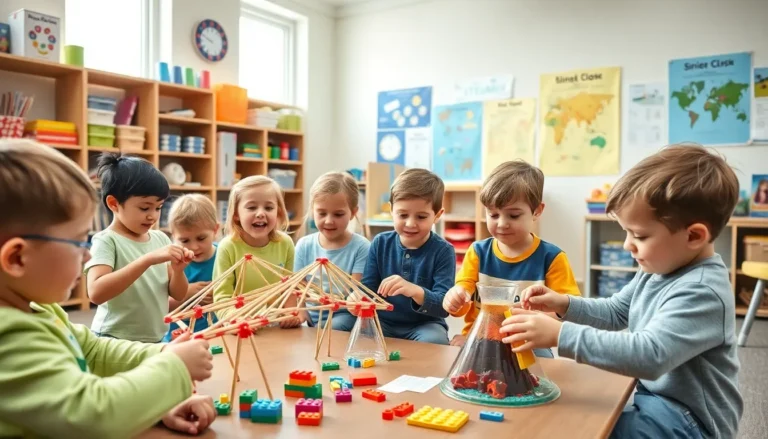Table of Contents
ToggleAdoption and fostering are more than just buzzwords; they’re lifelines for countless children seeking a loving home. Imagine being the superhero who swoops in to save the day, armed with nothing but love and a few parenting hacks. Whether it’s a snuggly toddler or a spirited teen, each child has a unique story waiting for someone like you to write the next chapter.
Understanding Adoption And Fostering
Adoption and fostering provide essential pathways for children in need of stable homes. Understanding these two processes aids potential parents in making informed choices.
Definitions Of Adoption And Fostering
Adoption involves a legal process where an individual or couple becomes the permanent parents of a child. This process grants the adoptive parents full parental rights. Fostering, on the other hand, temporarily places a child in the care of a family until a more permanent solution is found. Foster parents provide a safe environment while social services work to resolve the child’s situation. Each option serves distinctive purposes yet shares the common goal of providing love and support.
Importance Of Adoption And Fostering
Adoption and fostering play crucial roles in securing loving homes for children. The need for stable environments remains high due to various family circumstances, including neglect or abuse. By adopting or fostering, parents contribute to a child’s emotional and developmental needs. These supportive actions not only change a child’s life trajectory but also create a sense of belonging. Engaging in these processes fosters community bonds and encourages compassionate growth.
Types Of Adoption
Adoption comes in several forms, each catering to unique circumstances and needs. Understanding these types can help prospective parents choose the best path.
Domestic Adoption
Domestic adoption occurs within the same country. It typically involves adopting children from within the United States. Birth parents may voluntarily place children for adoption through agencies, attorneys, or foster care systems. In this type of adoption, prospective parents often have the option to choose an open, semi-open, or closed adoption. Factors like emotional connection and ongoing communication vary significantly based on the chosen approach. Statistics show that domestic adoptions in the U.S. number around 135,000 each year, making it a popular choice for many families.
International Adoption
International adoption involves adopting children from countries outside the United States. Families often seek children from regions where there is a high need for adoptive homes, such as Asia, Africa, and Latin America. This process typically requires extensive paperwork, background checks, and adherence to international regulations. Adoptive parents experience significant cultural considerations when bringing a child from another country into their home. In 2020, over 2,000 children were adopted from abroad in the U.S., reflecting its continued appeal despite regulatory changes.
Special Needs Adoption
Special needs adoption includes children with physical, emotional, or developmental challenges. These children often face longer wait times for adoption due to misconceptions and stigma. Agencies actively seek families willing to adopt older children, sibling groups, or those with disabilities. Support resources are available to help families navigating these specific needs. Adopting a child with special needs not only transforms their life but also enriches the family’s experience. Approximately 25% of adoptions from the U.S. foster care system involve children who qualify as having special needs, illustrating the importance of such placements.
The Adoption And Fostering Process
The processes of adoption and fostering encompass several key steps to ensure the welfare of children.
Steps In Adoption
Adoption begins with researching and selecting an agency or attorney. This choice impacts the entire adoption experience. Next, prospective parents complete an application, followed by home studies that evaluate their readiness. Training sessions equip individuals with knowledge about the adoption journey and parenting challenges. Afterward, matches occur between children and families based on specific needs. Legal proceedings finalize the adoption, granting parental rights to the adoptive parents. Finally, post-placement support helps families adjust, facilitating smoother transitions.
Steps In Fostering
Fostering requires initial research to identify local agencies or organizations. An application process follows, along with background checks to ensure safety. Home studies evaluate the living environment and the ability to meet a child’s needs. Training programs prepare foster parents for the challenges they might face. After approval, foster parents receive placements, providing temporary care according to the child’s situation. Regular visits by social workers occur to monitor progress and support the foster family. Collaboration with biological families remains an essential aspect, focusing on reunification whenever possible.
Challenges In Adoption And Fostering
Adoption and fostering present unique challenges that prospective parents and caregivers must navigate. Emotional and legal hurdles shape the experience significantly.
Emotional Challenges
Foster and adoptive parents often face emotional turmoil when bonding with a child. Difficulties arise if a child has experienced trauma, impacting relationships and trust. Parents may encounter feelings of inadequacy as they help children cope with grief, loss, or behavioral issues. Each child’s background contributes uniquely to these challenges, creating complex dynamics within the family. Parents also need to manage their own feelings about letting go if reunification occurs in foster care. Building resilience and seeking support from peer groups can help parents address these emotional obstacles effectively.
Legal Challenges
Legislation around adoption and fostering can seem daunting. Different states impose specific regulations, which can complicate processes for families. Parents must understand the legal implications of guardianship, rights, and responsibilities. Court involvement may require additional time and resources, elongating the wait for finalization. Navigating the adoption or fostering system demands considerable paperwork, background checks, and home studies that ensure child safety. Attorneys or agencies specializing in adoption can assist but may incur high costs, posing an additional challenge for families seeking to provide stable homes.
Benefits Of Adoption And Fostering
Adoption and fostering provide significant advantages for both children and families. Understanding these benefits highlights the impact of these processes on individuals and communities.
For Children
Stable homes enhance the lives of children in need. Emotional support contributes to their development and well-being. Access to education becomes more attainable for children within stable families. Nurturing environments promote positive growth and resilience. Studies indicate that children raised in loving settings often develop healthier relationships and exhibit improved emotional regulation. Loving families foster a sense of belonging, which is crucial for children who have faced trauma or instability. Ultimately, adoption and fostering empower children to realize their potential and pursue brighter futures.
For Families
Adoption and fostering cultivate deeper familial bonds. Families experience unique growth opportunities through the challenges and joys of raising children. They gain insights into resilience, compassion, and empathy. New experiences foster a sense of purpose among family members. Engaging with children from diverse backgrounds enriches family life, promoting appreciation for different cultures and perspectives. Involvement in the adoption and fostering journey can enhance family communication skills and overall dynamics. Opportunities arise for families to contribute to their communities while nurturing children in need.
Conclusion
Adoption and fostering represent powerful avenues for transforming lives. By opening their hearts and homes, individuals can create lasting impacts on children in need. Each child’s journey deserves a chance for stability and love, and every family can play a role in this vital mission.
The rewards of fostering or adopting extend beyond the immediate benefits to children. Families often find themselves enriched by the diverse experiences and connections formed through these processes. In a world where many children are still waiting for their forever homes, the call to action is clear. Embracing the roles of adoptive and foster parents not only changes lives but also strengthens communities.







